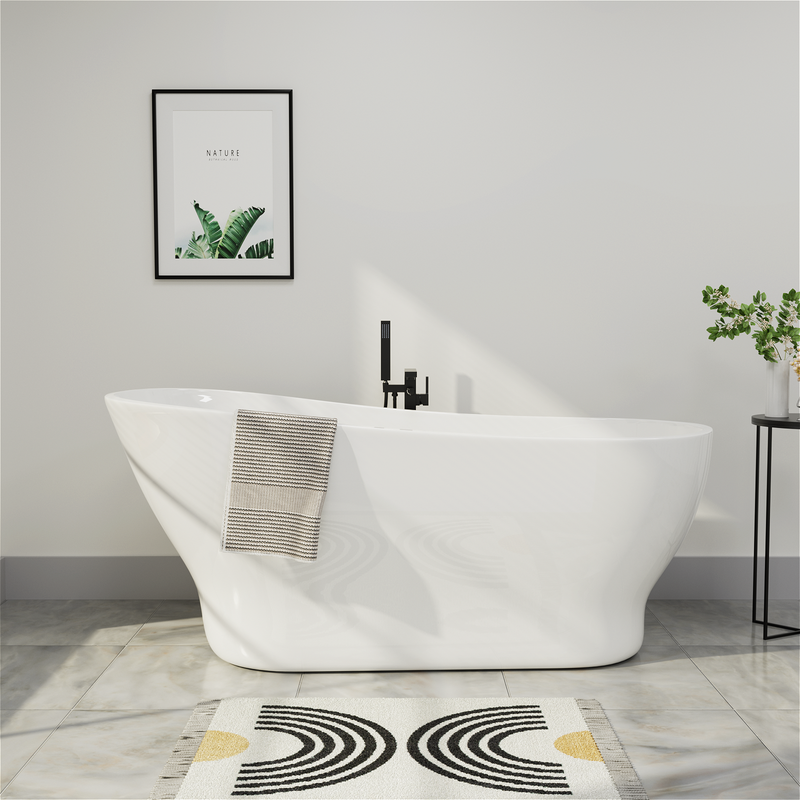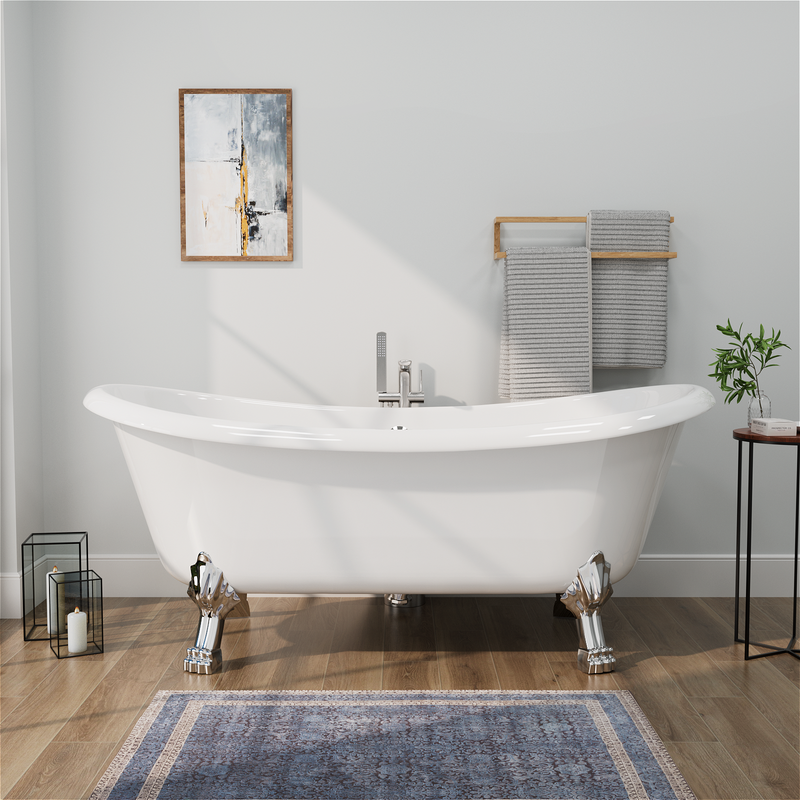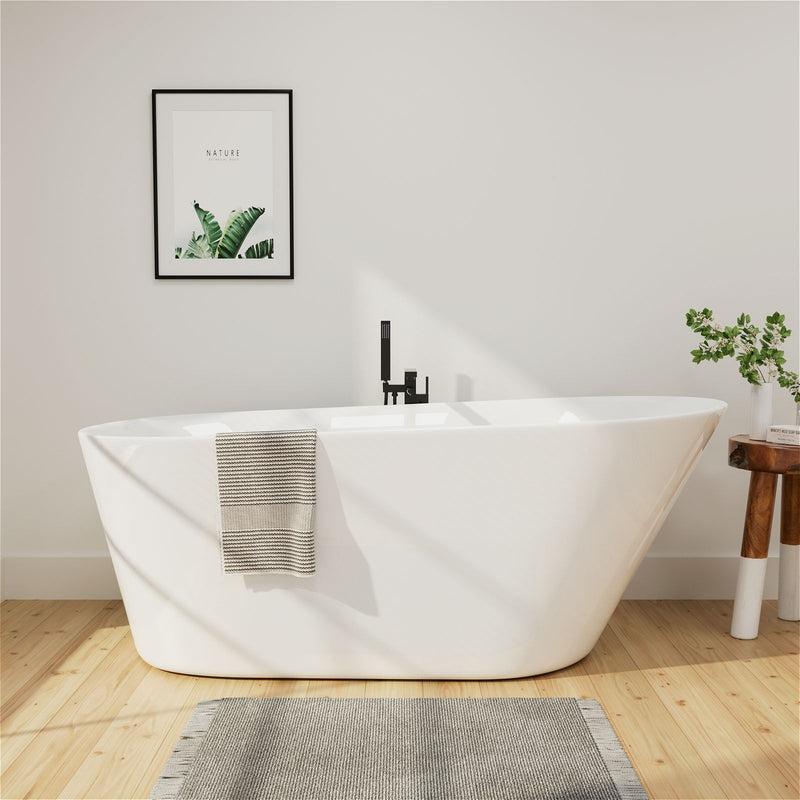Choosing the right drain location for your rectangular bathtub might seem like a minor technical detail, but this single decision can significantly impact your bathing comfort, installation complexity, and long-term satisfaction. While the tub's material, size, and style often get the most attention, the drain placement plays a crucial role in how the tub feels when you're using it and how much effort and money will be required to install it properly.
Rectangular bathtubs typically feature two main drain placement options: center drains and end drains. Each configuration comes with distinct advantages and considerations that make it more or less suitable for different bathroom layouts, plumbing configurations, and personal preferences. Understanding these differences before making a purchase can help you avoid costly modifications and ensure your new tub provides the comfortable, relaxing experience you're looking for.
This comprehensive guide will walk you through everything you need to know about rectangular bathtub drain locations, from the basic differences between center and end drains to how this decision affects comfort, installation, and compatibility with your existing plumbing system.
Center Drain vs End Drain: Understanding the Basic Configurations
The Center Drain Placement
Center drain bathtubs feature a drain positioned in the middle of the tub floor, creating a symmetrical appearance and balanced drainage pattern. This configuration is common in freestanding rectangular tubs and some contemporary built-in models, where the drain becomes a visual element rather than just a functional component.

From a practical standpoint, center drains can provide more uniform drainage across the entire tub surface, as water flows toward the middle from all directions. However, this placement may require more precise sloping of the tub floor to ensure proper water flow, which can sometimes affect the comfort of the bathing surface. Some bathers notice the subtle slope toward the center when lying in the tub, while others find it completely unnoticeable during use.
The End Drain Placement
End drain bathtubs position the drain at one end of the tub, typically where your feet would rest while bathing. This traditional configuration is most common in alcove tubs designed for installation against three walls, where the drain end connects directly to the plumbing in the bathroom wall.
The end drain configuration typically creates a more pronounced slope from the opposite end of the tub toward the drain, which some bathers find noticeable when lying down. However, this efficient drainage design has been the standard for decades in many residential bathtubs due to its straightforward connection to standard residential plumbing layouts and generally reliable performance.
Pros and Cons: Comparing Drain Location Performance
Advantages and Disadvantages of Center Drains
Center drains offer several benefits that make them appealing for certain bathroom configurations. One significant advantage is their symmetrical design, which works particularly well for freestanding tubs that can be viewed from all sides. This placement creates a balanced visual appeal regardless of how the tub is positioned in the room. Additionally, center drains can sometimes offer more flexible installation options since they're not dependent on proximity to a specific wall for drainage access.
However, center drains also present some challenges. The plumbing requirements for center drains are often more complex, particularly in slab foundations where moving drain pipes can be difficult and expensive. Center drains may also require additional structural considerations,
as the drainage plumbing typically runs beneath the tub rather than aligning with standard wall plumbing. In some cases, the subtle sloping of the tub floor toward the center can create a slightly uneven feeling underfoot for some bathers, though many users don't notice this effect during normal use.
Advantages and Disadvantages of End Drains
End drains have remained popular for several compelling reasons. Their greatest advantage is typically easier installation,
especially in bathroom layouts where the tub will be positioned against walls containing existing plumbing. This placement aligns well with standard residential plumbing configurations, potentially reducing installation time and cost. End drains also tend to have simpler drainage slopes that effectively channel water toward one end of the tub without complex contouring of the tub floor.
The limitations of end drains include potentially less flexibility in tub placement, since the drain end needs reasonable access to plumbing connections, usually through a wall. Some bathers also report that the more pronounced slope toward the drain end can be noticeable when lying in the tub, particularly in longer soaking sessions. From a visual perspective, end drains may create a less symmetrical appearance that some homeowners find less appealing in freestanding tub applications.
Comfort Differences: How Drain Location Affects Your Bathing Experience
Body Positioning and Support
The location of your bathtub's drain can subtly influence comfort through its effect on the tub floor's contour. To facilitate proper drainage, tub floors are sloped toward the drain, and this slope can sometimes be felt when you're lying in the tub. Center drains typically create a more uniform slope that radiates toward the middle, which some bathers find creates a more natural body position. However, others may notice a slight "low point" in the center that they unconsciously adjust to avoid.
End drains create a more directional slope from the head of the tub toward the drain at the foot end. Many people find this slope less noticeable since it follows the natural taper of the body, with the deeper water typically at the back where your torso rests. However, some taller bathers report that their heels tend to rest on the slightly sloped area near the drain in end-drain tubs, which can be less comfortable during extended soaks.
Water Depth and Immersion Experience
Drain placement indirectly affects your soaking experience through its influence on water depth distribution. In center drain tubs, water depth may be more consistent throughout the tub, potentially providing more uniform coverage for soaking. This can be particularly beneficial for those who like to change positions frequently while bathing or for couples sharing a larger tub.
In end drain tubs, water depth typically varies more noticeably from one end to the other, with the deeper water usually at the end where your back and torso rest. Many bathers prefer this configuration as it positions the deepest water where most of your body mass is located, potentially allowing for better shoulder and chest immersion without requiring as much total water. However, this variation might mean slightly less water coverage for your legs and feet, depending on the specific tub design.
Compatibility with Existing Plumbing Systems
Assessing Your Bathroom's Plumbing Configuration
Before selecting a bathtub based on drain location, it's crucial to understand your bathroom's existing plumbing setup. In most homes, drain pipes are positioned to accommodate standard end-drain tubs, with the plumbing typically accessible through the wall at one end of the tub area. If you're replacing an existing tub, noting the current drain position will help you determine how compatible different new tubs will be with your setup.

Center drain tubs often require significant plumbing modifications unless your bathroom was specifically designed to accommodate them. This is because the drain pipe typically needs to run under the tub to reach the center position, which may involve opening the floor to reposition pipes—a potentially costly and complex process, especially in homes with concrete slabs or finished ceilings below.
Installation Considerations and Modification Requirements
The complexity of installing a tub with a particular drain location depends largely on your bathroom's current configuration and construction. End drain tubs are generally simpler to install in most traditional bathroom layouts since they connect directly to standard wall plumbing. This typically means lower installation costs and fewer potential complications.
Center drain tubs often require more extensive installation work, as the drainage path usually leads down through the floor. This may involve cutting into the subfloor to run new plumbing lines and potentially reinforcing the floor structure to accommodate the drainage system. In some cases, raising the tub on a platform may be necessary to create proper drainage slope, which can affect the overall height and accessibility of the tub.
If you're considering a center drain tub but want to minimize plumbing modifications, some manufacturers offer adjustable drain kits that can provide some flexibility in connecting to existing plumbing. However, these solutions typically have limitations on how far the drain can be offset, so consulting with a professional plumber before making a final decision is recommended.
FAQs
Which drain location provides better drainage performance?
Both center and end drains can provide excellent drainage performance when properly designed and installed. Center drains may offer slightly more balanced drainage across the entire tub surface, while end drains utilize a more direct, directional flow. The actual drainage efficiency depends more on the slope of the tub floor and the diameter of the drain pipes than on the drain location itself.
Can I change the drain location on an existing bathtub?
Converting a tub from one drain location to another is typically complex and often not practical. The drain location is an integral part of the tub's design and structure. If you want a different drain location, you're generally better off selecting a new tub designed with your preferred drain configuration rather than attempting to modify an existing tub.
How does drain location affect installation cost?
End drain tubs usually have lower installation costs in standard bathroom layouts since they connect directly to typical wall plumbing. Center drain tubs often require additional plumbing modifications, such as rerouting drain pipes through the floor, which can significantly increase installation expenses. The exact cost difference depends on your specific bathroom configuration and local labor rates.
Does drain location impact cleaning and maintenance?
Drain location has minimal impact on cleaning difficulty, though some users find center drains slightly easier to access for cleaning the drain basket since they're not tucked against a wall. From a maintenance perspective, end drains may be slightly easier to access for plumbing repairs since they're typically connected to wall plumbing rather than floor plumbing.
Are certain drain locations better for specific bathroom layouts?
Yes, drain locations work better in specific layouts. End drains are ideal for alcove installations where the tub is surrounded by three walls. Center drains work well for freestanding tubs positioned away from walls or for installations where the tub is centered under a window or featured as a room centerpiece. Consider your overall bathroom layout when selecting drain location.
Conclusion
Choosing between a center drain and end drain for your rectangular bathtub involves balancing aesthetic preferences, comfort considerations, and practical installation factors. Center drains often provide a symmetrical look that works well for freestanding tubs but may require more complex plumbing modifications. End drains typically offer easier installation in standard bathroom layouts and have a long history of reliable performance, though they may provide slightly less flexibility in tub placement.
Your decision should factor in your bathroom's existing plumbing, your budget for potential modifications, and how sensitive you are to the subtle differences in bathing comfort between the two configurations. By carefully considering these elements before making your purchase, you can select a drain location that enhances your bathing experience while minimizing installation challenges and costs.
Remember that while drain location is an important consideration, it's just one aspect of selecting the right bathtub. The tub's dimensions, material, interior contour, and overall quality all contribute significantly to your long-term satisfaction. Taking a comprehensive approach to your bathtub selection will help ensure you enjoy your new rectangular tub for years to come, regardless of which drain location you ultimately choose.





